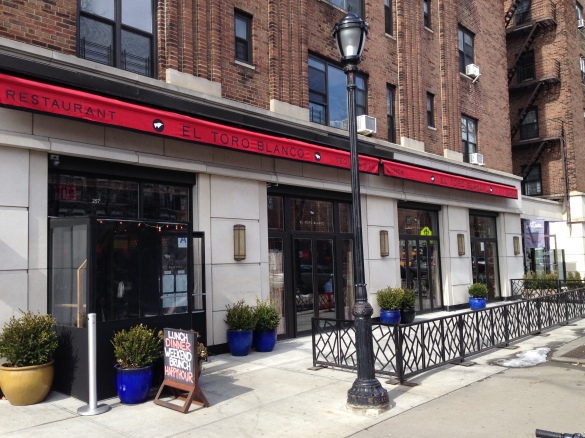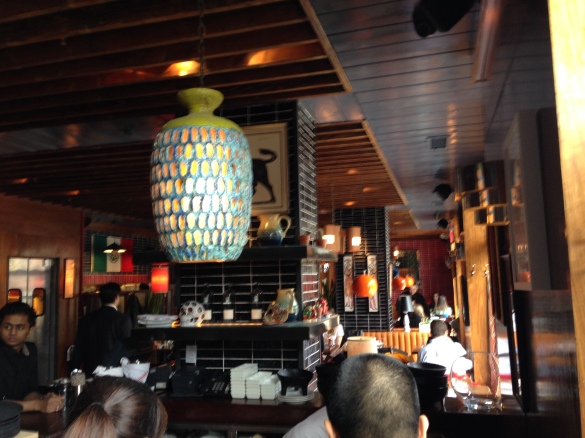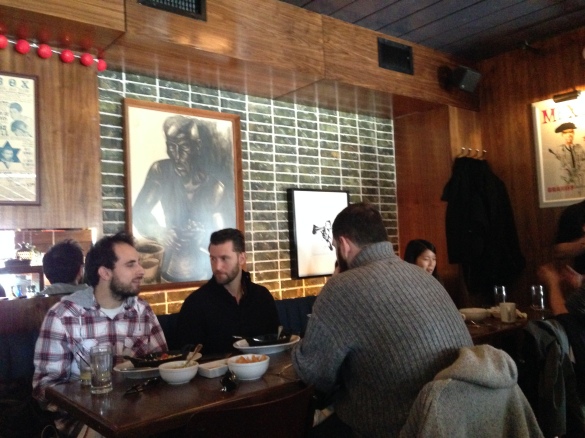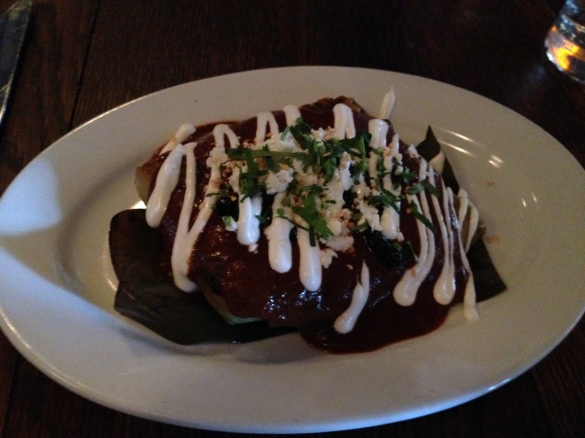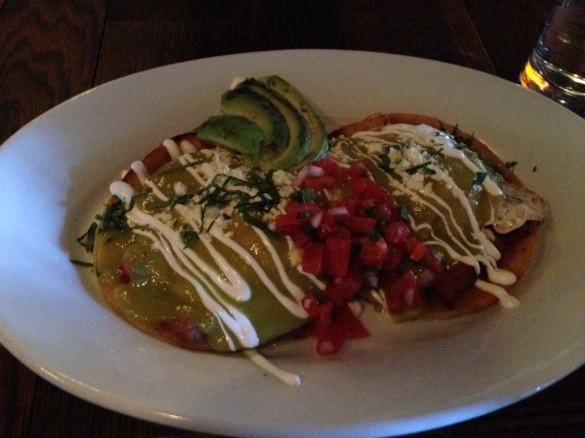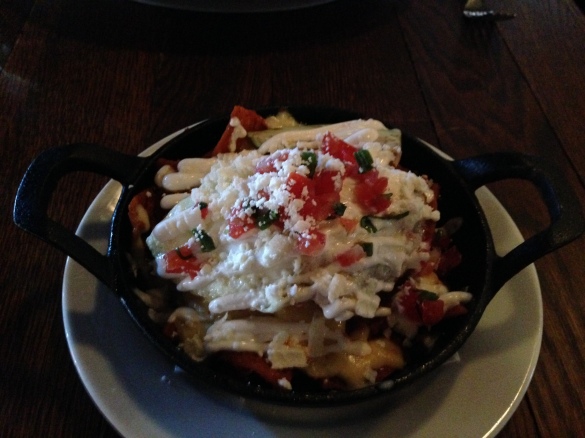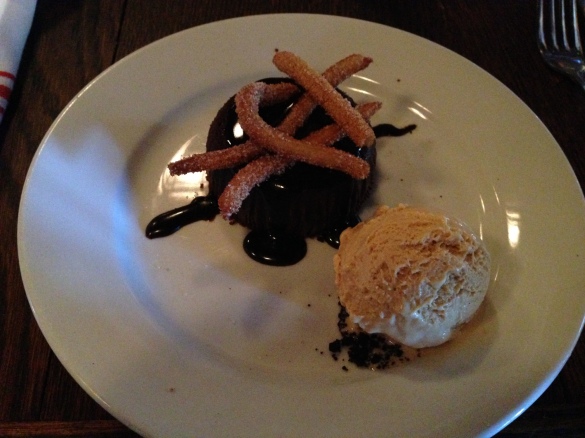
Afloat in this nebulous sea of my mid-twenties, it seems somewhat hypocritical to make remarks about an identity crisis. I find I am still very much chipping away at the jagged piece of stone that is my public persona, slowly working my way through the marble to pick and choose among the quirks and traits I’m truly comfortable with (as well as the deficiencies I need to acknowledge and accept). As I’ve gotten older, I’ve definitely become more confident in what makes me unique as an individual, and more importantly, to value that as something worth sharing with others. But it took a while to be all right with not just going with the crowd, for recognizing that your difference of opinion might actually add something to the discussion.
I think we sometimes forget that restaurants are run by people, and rather than being some autonomous hive-mind or giant Star Trek replicator (geekiness = one facet I am embracing), the people involved ultimately make decisions that craft a “personality” for the enterprise (yup, I went there). Granted, my view is only from the outside, but it seems like new restaurants have to go through the same sort of growing pains as everyone else, with a similar spectrum of awkwardness when it comes to adolescence. Some places are going to be that one cool kid who never had acne and went from Bar Mitzvah beefcake to senior prom king, but a lot of places have to reckon with getting food stuck in their braces for a few years before they bust out those shiny straight teeth.
I couldn’t help but feel like RiverMarket Bar and Kitchen in Tarrytown is in the midst of that growth spurt. I was there recently for a dinner, and found myself thoroughly enjoying the food, if a little uncertain of what tone the restaurant was trying to strike. It’s got a lot going for it, and I think has a huge amount of potential, once it settles on what crowd it wants to sit with at the cafeteria.
First Impressions:

Some of the outdoor seating on RiverMarket‘s huge patio — this side unfortunately faces the train station and Tappan Zee Bridge.
RiverMarket Bar and Kitchen is located in the Westchester town of Tarrytown. The restaurant sits only a few hundred feet from the Hudson, and is part of a huge redevelopment project along the waterfront, called the Hudson Harbor Complex. While the large patio offers lovely views of the river on one side, unfortunately if you turn the other way you have a nice panorama of the Tarrytown Metro North train station. Still, not all sidewalk seating in New York offers gorgeous vistas.

The “market” section of RiverMarket, where you can buy prepackaged goods and fresh produce from local sources.
As the name implies, RiverMarket has both dining and retail components, with an overarching focus on locally sourced ingredients. Just inside the entrance to the restaurant is an area lined with shelves stocked full of locally-grown heirloom tomatoes, milk and cheese from Battenkill Dairy, and bread from the famed Balthazar Bakery, not to mention the NY-based wine and spirits sold just next door.

Inside the restaurant itself, a mish-mash of rustic and industrial chic.
Walking further in takes you to the restaurant itself, which is decorated with a blend of rustic and industrial touches, combining wrought iron lighting fixtures and bar shelves with light wood tables and thick wooden beams suspended across the ceiling. This aesthetic, combined with the dress code for the staff (branded t-shirts with jeans), a classic rock soundtrack, and the robust craft beer selection, suggest that RiverMarket wants to be a slightly more upscale neighborhood spot. And I have no problem with that desire — I wish there were more spots like that in NY. The identity issues start when you pair the visual with the menu, which seems to have much loftier aspirations.

Our drinks for the night — the Brooklyn cocktail on the right, and the Red Newt Cellars Riesling.
It was yet again another birthday dinner (May/June are busy months in my family), but this time we were celebrating my father’s birthday — hence the Westchester locale. This time I was on my game and documented the drinks we ordered. My mother and I had glasses of the Red Newt Cellars Riesling, a wine from the Finger Lakes that was on tap at the bar, and ended up being a slightly sweet, clean tasting wine that paired well with my food. My father went for the Brooklyn Cocktail (Green Hook Ginsmiths Gin, Green Hook Ginsmiths Gin Liqueur, Angostura Bitters, Orange Peel), which I didn’t like, mostly because of the gin, but more importantly, he really enjoyed.
In what unfortunately ended up being a recurring theme for the evening, our server was initially confused and brought my dad a Brooklyn Brewery beer instead of his cocktail. She was very attentive and kind, but didn’t seem to know much about the menu. This meant she was perfectly happy to repeatedly go back and ask the chef to answer or confirm something, but didn’t inspire a lot of confidence in us about the staff’s ability to represent the restaurant. Then again, maybe we were snooty New York diners with unrealistically high expectations of servers. I think it’s hard to say where the line really is — I certainly don’t expect someone at the Olive Garden to know the intricacies of each pasta dish, but when your restaurant makes a big deal about where they source the ingredients, should the staff be required to know the ins and outs of those ingredients? Anyway, enough about the context, let’s get into the food itself.
The Food:
RiverMarket specializes in seasonal American fare, with some pasta and international influences thrown in (one might even say another example of California Cuisine). Pulling from the Hudson Valley and the Long Island Sound/Atlantic, there was unsurprisingly a fair amount of seafood, although through our collective orders we ended up running the gamut from starch to fish to fowl and beyond. To start, my mom got the RiverMarket Montauk Hardshell Lobster Bisque, I chose the Montauk Hardshell Lobster Salad, and my dad went with a half portion of the Green Herb Fettucine. Then for entrees my mom got a half-portion of the Potato Gnocchi, my dad ordered the Grilled Block Island Harpoon-Caught Swordfish, and I had the Roast Hemlock Pasture-Raised Chicken. And because it’s not a meal with my parents without dessert (or a meal with me in general), we finished up with the Strawberry Shortcake and the RiverMarket Cookies and a Milkshake. And then I dearly wished I could walk back to the Upper East Side from there.

Our complimentary chunk of crusty bread. Narcissa wins this one with their mini boule.
Things kicked off with a hearty slice of complimentary bread, presumably from Balthazar. It was an herbed loaf, rustic and crunchy, almost burnt on the outside. I still would rather have one of the Pepperidge Farm dinner rolls my mom would give us over a slice of Italian bread any day, but I guess that’s not really trendy.

The RiverMarket Montauk Hardshell Lobster Bisque, smooth and creamy, yet packed with flavor. Also a strong vote in favor of the merits of calamari.
We visited RiverMarket only a few weeks after our dinner at Narcissa, so a bit of comparison was inevitable. After the somewhat muddled lobster butter my mom had at Narcissa, I was glad that her appetizer had such a crustacean-packed punch. RiverMarket Montauk Hardshell Lobster Bisque (Warm seafood salad crostini) was a little worrying at first, arriving smooth and bright orange with nary a piece of lobster in sight. Even though it was a bisque, I thought there might be a few chunks of lobster on the crostini, but the wedge of bread was topped with herb-dusted circles of calamari instead. However, what the soup lacked in lobster meat, it more than made up for in flavor. This was the opposite of Narcissa’s lobster butter — pure, unadulterated lobster beaming directly from the broth to your tastebuds. The crostini was also a nice addition, the toasted bread soaking up the bisque while still retaining a bit of texture, so you had a lobster-carb hybrid. My mother doesn’t care for calamari, so I happily took them off her hands, since they were well-executed, just slightly chewy without veering into rubber territory, and full of flavor from the surrounding bisque and a light coating of red pepper and olive oil.

The Montauk Hardshell Lobster Salad, a true summer dish.
My appetizer ended up being my favorite dish of the night, and given the size, I might actually return and just have this as an entree. The Montauk Hardshell Lobster Salad (heirloom legumes, celeriac, avocado, orange citrus vinaigrette) was beautifully plated, very carefully bundled together in a layered tower of salad components. It featured an enormous quantity of lobster meat, with both a sizable claw and a tail that were only lightly seasoned with salt, pepper, and the orange citrus vinaigrette. The lobster was incredibly fresh, hitting that sweet spot of chewy, buttery, briny richness that epitomizes great shellfish. To be honest, I was pretty focused on the lobster when ordering, so I didn’t pay much attention to the heirloom legumes listed with it, but as a legume lover I was delighted to see a wide variety of beans, from butter beans to favas to these dark brown ones that looked like oversized black beans. They were all cooked al dente, soft without being mushy, and mixed in well with the assortment of greens, ripe avocado, and crunchy slivers of what I thought was carrots, but ended up being celeriac. The acid of the vinaigrette was the perfect way to bring the salad together and balance out the natural richness of the seafood. It just seemed like the ideal summer dish, fresh and bright and full of the season’s best.

The Green Herb Fettucine, with roughly formed but impressive handmade pasta, and a pile of lamb on top.
RiverMarket really has a handle on their pasta, as evidenced by my father’s continuing to reference his appetizer even days after our dinner. The Green Herb Fettucine (slow-braised hudson valley lamb ragú, fresh mint and olives) really bowled him over, specifically how fresh the noodles were. As with my lobster salad, this dish challenges the notion of “half-order” (or perhaps, implies a Godzilla-sized full portion), with a pile of verdant green strips of pasta topped with full chunks of lamb and a dousing of cheese. I was very impressed that the dish used pieces of lamb, rather than the shredded or ground meat you often find in ragus. It was braised to the point of holding its shape only until pressed upon by a fork, then falling to pieces. I actually think it’s a shame RiverMarket doesn’t have a lamb entree — I’d come back for a braised lamb shank or shoulder (maybe that’s more of a winter dish?). The fettucine itself was the thickest cut iteration I’ve ever seen, rustic and far from visually perfect, but infused with lots of great flavor. The whole thing was topped with stewed tomatoes, cheese, and a few olives to add some bite, and though my positivity towards olives is still very much a work in progress, I found myself enjoying them here, where they worked in contrast with the rest of the dish.

The Potato Gnocchi, another excellent pasta dish, if not exactly light fare.
My mother was also very impressed with her pasta entree, the Potato Gnocchi (Stone Broke Farms 100% grass-fed beef bolognese, roasted hen of the woods mushrooms). She also ordered a half-portion, and wasn’t even able to finish that (fortunately, my father and I are card-carrying members of the Clean Plate Society). Like the fettucine, this was another bowl full of large pieces of pasta and a hefty allotment of meat. If Narcissa’s gnocchi were delicately browned pillows of starch, RiverMarket’s were the equivalent of Sock ‘Em Boppers — body-pillow-sized chewy, gooey bon bons. I feel like you don’t see Hen of the Woods Mushrooms on menus that often, so it was wonderful to have them paired here with the hearty ground beef. While this was definitely one of my favorite dishes of the night, it’s a bit of a gut bomb, so I can’t imagine actually having this as your full entree. I was more than happy to pick at my mom’s leftovers, but I’d recommend splitting it as an appetizer so you can enjoy the flavors without giving up all your stomach space to the gnocchi dumplings.

The Grilled Block Island Harpoon-Caught Swordfish, unlike any piece of swordfish I’ve had before.
Both my father’s and my entrees had the opportunity to be relatively light dishes, if you ignored the starch component. The Grilled Block Island Harpoon-Caught Swordfish (roasted peach and heirloom tomato salsa, pea tendrils, creamy hudson valley polenta) was a revelation. Usually I shy away from swordfish because I’ve only encountered it as thick-cut and treated like the steak of the sea, cooked medium-well so it’s tough and sort of bland. But RiverMarket’s version was sliced thin and cooked so that it was as tender and flaky as any piece of sea bass or snapper, yet still retained that meaty, umami taste. My dad had initially ordered it to try out the salsa, which fortunately lived up to expectations and had him raving about it, bite by bite. I liked the sampling I had, but I think I’m just relatively old-fashioned when it comes to salsas — I’d rather have a pico de gallo or salsa roja over non-tomato-fruit-focused variations. The last lighter component was the greens, which at first glance appeared to be spinach, but as with my parsley root at Narcissa, ended up being a vegetable homoglyph — these guys were pea tendrils, and had a slightly bitter taste that worked well with the sweet salsa. What turned this plate into a hefty meal was the underlying rectangle of über-buttery polenta, which almost reminded me of the outrageously rich grits you find at some southern restaurants. It was absolutely delicious, and worked well with the brighter flavors of the rest of the dish, but man was it filling.

The Roast Hemlock Pasture-Raised Chicken, the only real disappointment of the evening, due to underseasoning.
The same thing happened with my Roast Hemlock Pasture-Raised Chicken (moroccan spices, lyonnaise potatoes, summer squash and asparagus salad, cardamom chicken jus), where the potatoes performed as a heavy anchor for the dish. I chose this dish on the server’s recommendation, and while it certainly wasn’t bad by any means, overall I was a little underwhelmed by it. I had expected the Moroccan spices to pack a punch, and while there was a bit of a warm cumin/cinnamon coating on the crisp and crackly skin of the chicken, the spices had failed to really permeate down into the meat itself. The bulk of the meat was also slightly on the dry side, except for the dark thigh meat, which I unfortunately had last because it was tucked underneath the rest of the chicken. This piece was rich and gamey and moist, and if I could, I’d tell the RiverMarket kitchen to drop the breast and make the dish entirely out of dark meat. The jus had good chicken flavor, although again I had trouble finding the cardamom in it, and we all know how I feel about cardamom, so this was a bit of a disappointment. My favorite part of the dish was probably the vegetable sides of summer squash and asparagus, which had soaked up all of the chicken juices, perhaps defeating their purpose but rendering them lip-smackingly delicious. My mother happily dug into the potatoes (a trade for the gnocchi, I guess), but I just wasn’t interested in them, finding them mushy and lacking the pop of the onions to break up their flavor. All in all, compared to the deft handling of the pasta and swordfish, the wimpy seasoning on the chicken just made it seem a little unattended to.

The adorably festive Strawberry Shortcake.
Now I’m never going to complain about oversized desserts, and RiverMarket definitely delivers on that front. My father got the Strawberry Shortcake, which is not listed on the website, suggesting it may not be a lock-in on the menu. Considering how much he enjoyed it, though, I think it’s worth making it a permanent addition. Since it was his birthday, the kitchen decorated the plate and, in an inspired move, put a candle in one of the fresh strawberries. I usually don’t go for strawberry shortcake because so often the “cake” is a bland poundcake with little flavor, leaving a soft texture throughout that I find monotonous (I’m a heterogeneous texture fan, okay?). RiverMarket’s version, however, was made of two real biscuits (short cakes, I guess) sandwiching fresh chantilly cream with macerated sliced strawberries, and a drizzle of caramel on top. The biscuits had real heft to them, with a crust that required a little bit of pressure to break through to the softer interior, and it was nice to have thick slices of strawberries so their unadulterated flavor could shine through. Of course, my favorite part was the fresh whipped cream (no shlag, but pretty damn good).

The RiverMarket Cookies and Milkshake — sometimes all you need is simple, straightforward sugar.
But let’s be honest, the RiverMarket Cookies and a Milkshake (Espresso chocolate chip, snickerdoodle, chocolate brownie, creamy vanilla thick shake) are way more my kind of dessert. They reminded me of the amazing Cookies and Milk plate you can get at Jane in SoHo (check it out if you’re unfamiliar, it is worth it to eat there just for the eventual dessert). RiverMarket gives you three piping hot cookies, warmed to the point that the chocolate chips in the espresso cookie have melted down to little puddles that require a fork to properly eat. Alongside this small bag of cookies is a tumbler of vanilla milkshake, simple and utterly satisfying in the way only comfort food can be. In fact, for all of my high-falutin’ talk of food, textures (not to mention RiverMarket’s own claims to regional sourcing), our server said the ice cream in the shake was probably regular ol’ Breyers, since they were out of the local creamery’s milk they typically use to make the ice cream in house. Regardless of store-bought vs. hand-churned, the shake was tremendous — blended just to the point of still having real clumps of ice cream in the liquid, so you could sip it or attack it with a spoon, depending on your choice of strategy and level of desire for cookie-dunking. The chocolate brownie and the snickerdoodle were both solid cookies, but the espresso chocolate chip had wonderful soft-baked dough and gooey pools of chocolate with a real depth of flavor that contrasted with the straightforward vanilla shake. And I wasn’t upset about more whipped cream and chocolate syrup in my life. It looks like a small package, but this was actually a lot of dessert packed into a compact dish, and I’d happily go back to RiverMarket for a drink, some cookies and a shake to watch the sun set on the Hudson. Now those are some simple pleasures.
Final Thoughts:
I think when it comes down to it, RiverMarket is very close to being a slam-dunk. There are dishes that are less successful than others, but that’s true at any restaurant, and for the areas where they do excel, you’re getting large portions of great food for a pretty solid price. It seems like the easiest answer to RiverMarket’s highbrow/lowbrow identity problem is to be well-informed without adding pomp-and-circumstance. If a grounded, lowkey setting is your ideal, embrace that, but recognize that an emphasis on local sourcing means your staff should know those producers. They don’t have to be sommeliers or graduates from the CIA — in fact, I’d rather chat with a townie who’s invested in Tarrytown as their home.
It’s a small change that I hope will happen naturally, since RiverMarket appears to be a pretty popular place. I know I’d like to go back for brunch or lunch before the summer’s out, so I can enjoy the beautiful outdoor seating (and some more of that lobster). So if you’re coming north to enjoy a brief break from the hot concrete of Manhattan, consider jumping on the train to Tarrytown. You’re only a short hop away from RiverMarket Bar and Kitchen, where you can see what the Hudson Valley has to offer without emptying your wallet. It may still be in its gawky teenage years, but as a former awkward teen can attest, if you learn to appreciate strengths and acknowledge your weaknesses, you’re well on your way to a bright future.
RiverMarket Bar and Kitchen
127 W. Main St
Tarrytown, NY
http://rivermarketbarandkitchen.com/
































































